Crossed perspectives: Africanists in the municipal collections and the work of Rhode Makoumbou
On the occasion of the Heritage Days 2022, around the theme ”traces of colonization”, the municipality of Woluwe-Saint-Pierre is showing several works from its heritage collection.
Woluwe-Saint-Pierre has a special connection with the arts, as many artists lived and established their studios on the territory of the municipality, such as Emile Fabry, Philippe Wolfers, Arthur Dupagne or Fernand Allard l’Olivier.
The major exhibition of 2003 entitled “Congo and Belgian art” was the occasion for a major retrospective on the so-called Africanist movement and the works presented here were acquired at the end of this event.
The paintings and sculptures exhibited today focus on the last period of this artistic movement, with the second generation of artists who travelled to Congo or lived there during the last years of colonization.
Here, the works of these artists who were active in the colony are confronted with the work of contemporary artist, Rhode Makoumbou, a native of Congo.
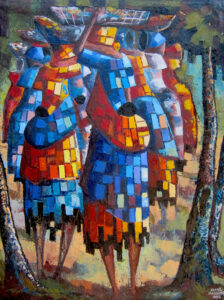
Rhode Bath-Schéba Makoumbou
Born in 1976 in Brazzaville, Republic of Congo
La foule au marché
Huile sur toile
148 x 99 cm
2014
Rhode Bath-Schéba Makoumbou has been immersed in the world of art since she was very young. Daughter of painter David Makoumbou, she has been familiar with her father’s studio since childhood. It is really at the dawn of the nineties that she begins an advanced artistic apprenticeship to fully commit herself to art.
She likes to define herself as an archival artist of the cultural memory of Africa in general and of the Congo in particular. Her work, which focuses on themes related to daily life, proposes to capture the last situations and moments of an existence that is fading away in favour of a modernisation of lifestyles. The plastic challenge is to give an account of a society in mutation and to approach its specificities as closely as possible. It is a question of restoring the states of contemporary society through a generous and tender look at anonymous people captured in their everyday life.
His favourite technique is oil painting with a knife. The use of vibrant and warm colours highlights both human figures and nature. With the work entitled Le Passage en barque, painted this year, the artist synthesises the balance between human activities and nature in the best possible way.
Much of Rhode Bath-Schéba Makoumbou’s work is inspired by traditional African sculpture. Inspiration from movements such as Expressionism and Cubism are also present in her work.
In addition to painting, since 2002 the artist has created a number of sculptures in composite materials (sawdust and wood glue on a metal structure) representing village trades that are tending to disappear.
One of Rhode Bath-Schéba Makoumbou’s most striking works is the life-size sculpture of Patrice Lumumba created in 2018 and presented at the Ravenstein Gallery. It is a reminder of the independence speech of 30 June 1960 delivered in Kinshasa by this anti-colonial Congolese activist and politician.
For her artistic career, Rhode Bath-Schéba Makoumbou has received many prestigious awards, notably in 2012, with the Grand Prix des Arts et des Lettres du Président de la République du Congo. In 2013, the artist was elevated to the rank of officer in the Congolese Order of Devotion by the President of the Republic Denis Sassou-Nguesso.
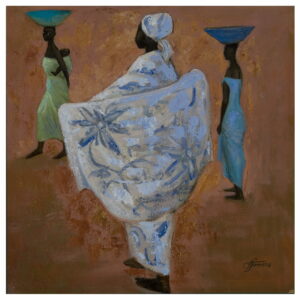
Francine Somers
Gand, 1923-
Femmes en bleue
Huile sur toile
61 x 61 cm
1953
A multidisciplinary artist, Francine Somers showed artistic tendencies at a very early age. Evolving in an environment linked to the arts, her father, a jeweller and goldsmith, gave her her first drawing lessons. Between 1936 and 1943 she attended the Royal Academy of Fine Arts in Ghent where she obtained a gold medal. Her artistic training oriented towards sculpture and bas-relief continued between the academies of Leuven (1956-1958) and Etterbeek (1960). From 1977 to 1979, she also perfected her chiselling skills at the Brussels School of Arts.
Her artistic experience with the Congo took place in the early fifties. She lived in Goma on the shores of Lake Kivu from 1951 until 1954. This change of environment would have an impact on her painting. Indeed, the light so particular to the Congo renews her style with the use of bold colors, it offers lines with flowing contours and compositions where the human figure is central.
The work acquired by the commune of Woluwe-Saint-Pierre, entitled “Woman in blue” is representative of the work of Francine Somers, on the one hand by the choice of the subject and on the other hand, by its treatment. The central figure, treated from behind, is emphasized, giving pride of place to the representation of the garment where decorative plant motifs are displayed.
This tightly framed foreground, accentuated by the size of the canvas, is also highlighted by a plain background where two female figures stand out on either side. One carrying a child on her back and the other with a tray on her head. The use of sober and mineral colours, associated with a composition where the three figures relate to each other, in particular by the gaze of the woman with the child, demonstrate the artist’s favoured themes such as maternity and childhood but also his empathic view on the female condition.
In addition to these themes, research and representations related to movement and dance have played an important role in the work of Francine Somers throughout her artistic career. It was during her stay in the Congo, invited by King (Mwami) Charles Mutara of Rwanda who appreciated her work, that she studied traditional dances and transposed them into an energetic and lively style. Her interest in dance and the rendering of movement will be a constant in her work, with, in 1967, a series of sketches that capture the atmosphere of the rehearsals of Maurice Béjart’s Ballet du XXème siècle produced at the théâtre de la Monnaie.
Her numerous sketches and designs reveal another aspect of her work, the art of the medal. Throughout her career, she received numerous commissions for commemorative medals, which recall African scenes or personalities.
In the fifties and sixties, she was also the author of numerous posters for the Colonial Lottery of Belgium, the current National Lottery.
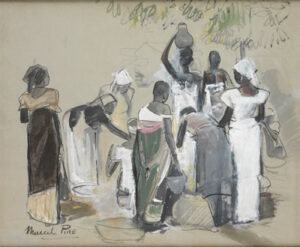
Marcel Pire
Schaerbeek, 1913 – Opheylissem, 1981
Scène de marché au Katanga
Encre, gouache, crayon sur papier marouflé
50 x 60 cm
1956
The Pire family includes many travelling artists. Four generations have travelled the world, particularly in Africa and the Congo.
Marcel Pire, son of Ernest Pire and father of Ferdinand Pire Ferdinand, studied at the Brussels Academy of Fine Arts in the workshops of Jean Delville and Alfred Bastien.
The post-war period in the Congo offered interesting opportunities for artists. Awarded a gold medal at the end of his training at the Brussels Academy of Fine Arts, Marcel Pire took part in exhibitions in Belgium and France, notably in 1937 at the Salon des Indépendants in Paris. Subsequently, he left on an artistic mission to the Congo in 1951 at the invitation of the Union minière.
During his stay in the Congo, in addition to being a painter, he was also a journalist and wrote a series of articles between 1952 and 1953 in the Mercure Africain.
A painter of still life and landscapes, he worked in Bukavu on the banks of Lake Kivu. His favourite subjects are representations of daily life. The work entitled “Scène de marché au Katanga” (Market scene in Katanga), painted in Indian ink and gouache, shows a group of women caught in their daily activities. The variety of postures, the contrasts in the clothes and the highlights of white gouache make this a particularly lively scene, sketched with an agile line. The taste for colour and abundant scenes is also transposed onto the canvas, where the artist is fond of the saturated tones of women’s clothing and where his palette evolves according to the frank and brilliant light present in Africa.
Marcel Pire is also the author of an important work on painting published in 1965.
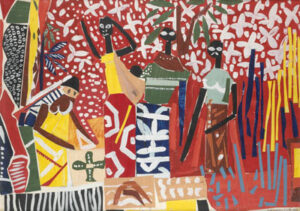
Ferdinand Pire said Ferdinand Pire Ferdinand
Bruxelles, 1943 –
Le marché congolais
Collage et gouache sur papier marouflé
50 x 60 cm
1961
Son of Marcel Pire, he begins his artistic training with his father. He also attended the Academy of Fine Arts in Brussels in the drawing section and the one in Cape Town until 1962. Numerous trips mark out his artistic career.
“The Congolese market”, created in 1962, is a work of youth of the artist. He was only 19 years old when he executed this piece using the technique of paper cut-outs painted with gouache. It is a plastic reinterpretation of the traditional market scenes of the previous generation. The strongly stylized human figures are built from geometric elements and random forms where the color brings all the expressiveness to the whole. This explosion of colors as well as the indented and fragmented contours of the elements contribute more to the rendering of a personal impression rather than to dwell on a faithful or illusionist representation of reality.
The artistic career of Ferdinand Pire Ferdinand would continue with research oriented on the églomisé technique, a process for painting behind glass. The plastic and technical mastery that he acquired on this support earned him numerous distinctions and awards in Belgium and on the international scene.
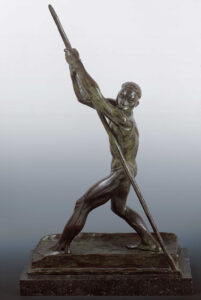
Arthur Dupagne
Liège, 1865- Bruxelles, 1961
Piroguier
Bronze
43 x 72 cm
2ème tiers du 20 e siècle
Son of a wrought iron worker, Arthur Dupagne’s artistic career began with evening classes in sculpture at the Royal Academy of Fine Arts in Liège.
When he arrived in the Congo in 1927 as an industrial engineer for the Société Internationale Forestière et Minière du Congo, he became interested in local sculpture. It was during his stay in Tshikapa that he observed the woodwork of the Tchokwe ethnic group and perfected his style. Impressed by the local techniques and drawing on his technical knowledge, thanks to his scientific training, he proposes artworks where the monumental aspect predominates and from which power and strength emerge. Often qualified as art deco with a late classicism, his works reflect a context where the emphasis is put on a positive representation of the colonial enterprise.
The decorations created for the World’s Fairs, in New York in 1939 or in Brussels in 1958, propose to illustrate the beneficial changes in daily life brought about by colonization. This aspect that depicts the colonial enterprise as a march of progress with a civilizing aim is also visible in the choice of themes treated by the artist. Indeed, his most important projects concern official commissions on the territory of the Congo with notably the monument to the portage in Matadi, the monument to the 50th anniversary of the railway or the heroic statue of Morton Stanley intended for Leopoldville.
In addition to the monuments and the large decorations, Arthur Dupagne’s work consists of an autonomous statuary in which there are multiple representations of the African man. One of the artist’s recurring themes is that of the paddler. It is characteristic of his plastic arts production by highlighting a vigorous, powerful body but where the individuality of the model is erased, thus denying his singularity. This treatment that he adopts for the realization of human figures, draws from a repertoire of classical inspiration. The modeling of the bodies is characterized by a successful synthesis between references to the antique and a strong stylization of the whole.
The paddler presented here is depicted at the moment of action, seized in the effort, muscles tense, it anchors a stereotype where technical progress is not yet present.
Dupagne’s artistic career began in earnest upon his return to Brussels. He participated in numerous exhibitions and a retrospective was organized in Tervuren in 1954. He was a prolific sculptor, his work comprises over 350 listed pieces.
